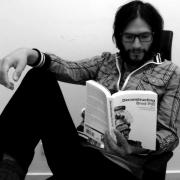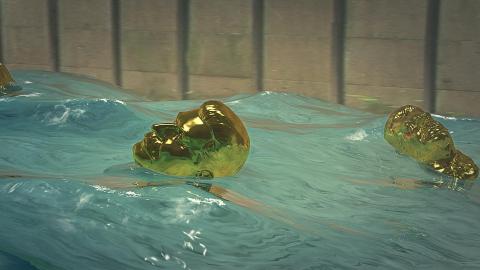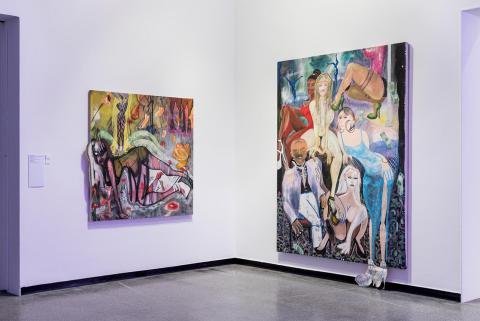Wicked Hotel
Here’s a strange piece of colonial trivia to spice the tedium of art criticism: the term ‘British Empire’ was coined by an alchemist called John Dee. Once a close advisor to Queen Elizabeth I, Dee’s political career suffered a torturous decline as he engaged in illicit conjuration by hiring the services of Edward Kelly (among others), a scryer who employed crystals to speak with ‘angels’. The goal of these entities—which includes archangels such as Gabriel, Michael and Uriel—was to materialize the apocalypse and subjugate humans to God, a fatalistic scheme that was revealed over countless seances. While these beings initially professed benign values, their presence eventually acquired a malignant tone, forcing John Dee to make choices, political moves and lifestyle changes that arguably ruined his life. One of the most gratuitous requests came from an angel called Madimi, who instructed Dee and Kelly to swap wives (I mean, why not), a command they both followed and which seems to have deteriorated their relationship (esoteric broing gone wrong).
One may imagine macabre endeavors, such as speaking with decadent angels, to take place in special rooms: elevated spaces that bring the (un)holy closer to the earthly. However, the scrying sessions performed by the pair took place in common places, such as Dee’s study—everyday rooms of unremarkable significance. Bringing forth the idea that horror is banal (and banality is horrible) despite our wishes to separate anxieties from the quotidian.
The notion of fear penetrating trivial spaces attracted me to Neon Parc’s suite for Spring1883 at the Establishment Hotel, which is curated to align with the horror genre. While the works are individually strange, their collective presence—and the knowledge that they were freighted to this space like a summoning—disgorges a higher eccentricity in the form of a shadow. This freakish spectre, which haunts the space by way of choices, is that of a ‘collector’, as one encounters an authorial voice in the precision that connects these pieces. This collection is decisively creepy and one can’t help to conjure Faust and suspect that someone, somewhere, sold their soul to something to build their wealth.
I assign a ghostly quality to the authorship behind the selection of these artworks (rather than recognising it as Neon Parc’s curatorial project) because the booth, unlike other galleries inhabiting the hotel, appears to be premised on an illusion: the idea that one is witnessing ‘real’ and permanent décor rather than the fleeting unpacking of a gallery. Like a ‘haunted house’ attraction, this fiction is also blatantly manifest as one is continually aware of its fabrication. The sense that one is navigating through the dwelling of a morbid collector is thus akin to a theme park of sorts. This sensibility is exacerbated by a playlist that sustains a hyper atmosphere with themes from Hellrasier, Halloween, It Follows, Stranger Things, Alien, Amityville Horror, Deep Red, The Witch and Phenomena among others. We know this is a constructed booth but it feels like an encounter with traces of supernatural psychopathy, a channeling of strange beings that communicate via objects.
One of the first works on display is Maria Kozic’s Nosferatu (2017), a portrait of a vampire drawn from the 1922 film bearing the same title. The small painting belongs to a wider suite of works in synthetic polymer paint on cardboard depicting a variety of monsters from yesteryears. The everyday nature of Kozic’s materials implies a normalisation of theatrical monstrosity, which now inhabits the realm of kitsch rather than horror. The vampire is perhaps the most appropriate form of evil one may quote in the context of Spring1883, as they are often depicted as a lavish figure of high taste. While the connection between capitalist practices and bloodsucking is painfully obvious (so tedious that the mere thought of typing it gives me psychosomatic RSI), it is the most likely beast to book a few nights at the Establishment Hotel’s suite. Another work employing similar horror references is Benjamin Armstrong’s Web in Front (2011), an ink on paper depicting an eyeless face with a spider web held in the foreground by two phantasmal hands.
Matilda Davis’s paintings also revisit the anxieties of the early 20th century by mimicking the surrealist style commonly associated with Remedios Varo, Leonora Carrington and Yves Tanguy. Some of her work is fittingly hung above the bathtub, a site that mirrors the liquid states and intense reveries that permeate her practice. Glowing wildness, burn me when my eyes are closed (2019) is exemplary in this regard, as it depicts a biped horse seemingly dressed as the planet earth holding an insectoid infant with a leaf on its head. This creature is standing at the centre of a roofless room with multiple entries and exits that are being swamped by fantastical creatures amidst instruments of magic. This imagery speaks to a different kind of fear, perhaps one that is premised on unknowability, nightmarish states or subconscious mechanisms.
Matthew Harris stands out with a series of cartoonish paintings on acrylic depicting ‘naughty’ scenes with a graphic style. Clusterfuck (2019) shows a friendly orgy of demons sexing through the rear in a circle loop as gazed through the trope of the ‘hell mouth’, which is stylized to resemble something along the lines of Nickelodeon. The work appears to recuperate medieval tropes through a camp lens while updating them with references to millennial culture. One of the most captivating aspects of this gesture is that it echoes a wider cultural interest in revisiting medieval imagery with irony, such as to create memes spoofing scenes that were once revered or inspired dismay (for instance, the Classical Art Meme depicting a skeleton tugging a nun’s habit that is hysterically captioned to say “Gurl, is this silk?”). His other paintings on show are the triptych Judith with the head of Holofernes (2019), which references the classical theme of decapitation, and Rich Pig (2019): a graphic work with a pig drinking and smoking a cigar while burning money.
Walking out of this room, which stands on the top floor of the hotel, I felt the dark embrace of unnatural forces (kinda). The depth of conjuring horror in the context of an art fair lies in the idea that materialistic concerns, such as riches, are intimately linked to wishes granted by the beyond. While one may create a moralistic connection between money and demons, it is also likely for angelic forces to enjoy precious metals. The angels that spoke to John Dee, for instance, often demanded expensive seals made of gold for reverence and protection. I must say at this point, that I never quite imagined myself writing a review about a booth in an art fair, yet, this context creates a unique atmosphere for Neon Parc by tapping into the superficiality of evil. The excesses that surround this room provide an excellent backdrop for these artworks. Perhaps this is because crowds in art fairs are like the coven in Rosemary’s Baby: a bunch of freaky people with creepy money. This is their collection.
Other artists on display include Peter Graham, Darren Sylvester, Matilda Davis, Yvonne Todd, Mike Kelley, Dorothea Tanning, Janet Burchill & Jennifer McCamley, Damiano Bertoli, Hans Bellmer, Dale Frank, Mikala Dwyer, Irene Hanenbergh, Nell, Jelena Telecki, Laurie Steer, and Lewis Fidock.









